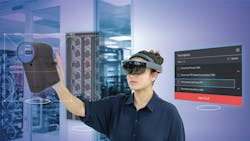What if all of your plant staff were your best staff, regardless of how long they’ve been around? I apologize for leading with a tagline from a commercial Honeywell flyer, but I think it really gets to a key point of what the company is releasing here this week at the ARC Industry Forum in Orlando.
Honeywell Connected Plant Skills Insight Immersive Competency combines mixed reality with data analytics to create a cloud-based simulation tool for training plant personnel on critical work activities. It is designed to bring new industrial workers up to speed quickly by enhancing training and delivering it in a more active environment using augmented reality (AR) or virtual reality (VR).
Part of what’s so key about this product that Honeywell is introducing is the workforce issue we’ve all heard so much about—how the Baby Boomers so prevalent in industry are getting set to retire, the young folks aren’t as interested in taking on jobs in manufacturing, and we’re lacking the skillsets to get the jobs done.
This seems like fairly abstract hand wringing until you hear an actual scenario of how that played out at a major oil and gas facility. During a press briefing this week, Youssef Mestari, connected people program director for Honeywell Process Solutions, described a customer that ended up with a sizable incident because of a thorough electrical check that it must perform only every eight years. Given the infrequency of this inspection, the person who actually knew how to perform the tasks had since retired. So they sent a couple Millennials out with training sheets to walk through the 97 steps needed to get the job done.
Everything went well up to step 55, Mestari explained. But then the instructions told them to pull a fuse from a fuse box—the problem being that there were two fuse boxes, and they didn’t know which one to pull. “They pulled it from one, and nothing happened. So then they pulled it from the second one,” Mestari said. “Fifteen minutes later, a fire lit up on the compressor.”
They had to get everyone out of the facility, which was then shut down for three weeks, with some $10 million in production lost.
“More and more of these stories are going to happen in the coming years,” Mestari said, backing up his statement with some relevant statistics:
- 50 percent of the workforce will retire in the next five years.
- 38 percent of those working are actively looking for a different role.
- It takes 12 months on average to train staff after an upgrade.
- The average company tenure for Millennials is two years.
Some more stats: Active learning (learning by doing) has an 80 percent retention rate three months after the training; passive learning (typical in a classroom setting) has only a 30 percent retention rate. To achieve an active learning mode, Immersive Competency uses Microsoft’s HoloLens and Windows Mixed Reality headsets to simulate various scenarios for Honeywell’s C300 controller that train and test personnel on their skills. Simulating specific job activities through virtual environments that are accessed through the cloud, Honeywell’s system offers a natural way to interact and communicate with peers or a trainer. Similar to a flight simulator, trainees can safely experience the impacts of their decisions.
With Immersive Competency, Honeywell has found it could reduce technical training from six months to two months, Mestari said. Employees’ training progress is tracked as part of a formal competency management system. In addition to doubling the retention rate with active learning, Honeywell also saw up to 15 percent higher worker efficiency.
The immersive experience of the technology comes through either an AR or VR apparatus, depending on how customers want to approach it or even what equipment they might already have. Honeywell has made it device-agnostic but prefers AR—particularly HoloLens—for a couple reasons. “HoloLens has compute power embedded, so you don’t have to be wired to a laptop. It’s very convenient as a user experience,” Mestari pointed out. “We also prefer augmented, not virtual reality so that the individual can stay in touch with reality; he’s aware of the environment surrounding him.” Too often with VR, he added, people can forget about the objects that are around them, causing safety risks and also dizziness.
The results come through simulation-based scenarios that Honeywell has built around assets—how to install, how to repair, how to maintain, etc. Immersive, on-demand learning is provided that requires personnel to learn through doing and to apply critical thinking. The system also does a knowledge and competency assessment, and can directly link people performance to plant performance.
This link to plant performance is a breakthrough in training, according to Mestari. “This has never happened in any competency program,” he said. “Success is not based just on how many people were trained, but the results.”
In fact, Immersive Competency is an outcome-based program. “The pricing is only defined once we understand the objectives and outcomes we want to achieve,” Mestari said. “We get paid based on the performance as well.”
The unique approach to industrial training and competency development is an example of the creative drive to digital transformation, noted Lorraine Bardeen, general manager for Mixed Reality at Microsoft. “This is the first solution that directly links industrial staff competency to plant performance by measuring the training’s effectiveness based on real outcomes,” she added.
The system is part of Honeywell’s Connected Plant initiative, which uses advanced analytics capabilities to help connect process, assets, people and enterprise to maximize performance.

